
Home & Garden Sundries Supplier
MIF+Garden, Your Bridge To Happy Life- contact us
james.li@mif-garden.com
sales@mif-garden.com
sales001@mif-garden.com - call us anytime
86-18616678980
86-18165659162
86-18923082607

Pubdate: 2024-04-11
An Introduction to Bread Bins: A Staple in Modern Kitchens
Bread, a staple food in many cultures, has always required proper storage to maintain its freshness and palatability. Over the centuries, methods of bread storage have evolved from simple cloth wrappings to more sophisticated containers, leading us to the modern-day bread bin.
1. **Brief History of Bread Storage** Initially, bread was often stored in cloth bags or wrapped in cloth to preserve its freshness. As technology progressed, wooden boxes and metal containers became popular for their durability and improved storage capabilities. In the late 19th and early 20th centuries, the invention of plastic revolutionized the industry, leading to the widespread use of plastic bread bins due to their affordability, lightness, and ease of cleaning.
2. **Importance of Bread Bins in Modern Kitchens** In today's kitchens, bread bins serve a crucial role. They not only keep bread fresh but also add a touch of organization and style to the countertop. Bread bins are designed to be airtight, preventing moisture loss and keeping the bread soft and flavorful for longer. Moreover, they protect the bread from pests and contaminants, ensuring its hygiene and safety for consumption.
3. **Preview of Topics to Be Covered** In this article, we will delve deeper into the world of bread bins, exploring their various types, materials, and designs. We will discuss the functional features that make them indispensable in modern kitchens and examine the aesthetic and decorative aspects that enhance their appeal. Furthermore, we will provide a comprehensive buying guide to help you choose the perfect bread bin for your needs and offer tips on caring for and maintaining your bread bin to extend its lifespan. So, stay tuned as we embark on this journey through the essentials of bread bin ownership.
*Types and Materials of Bread Bins** Bread bins come in a variety of types, each made from different materials that cater to different needs and preferences. Let's explore the three most common types of bread bins and their respective materials.
1. **Wooden Bread Bins** - **Classic and Rustic Appeal**: Wooden bread bins are often associated with a classic and rustic charm. They bring a touch of warmth and natural beauty to the kitchen, complementing traditional and country-style décors. - **Durability and Easy Maintenance**: Wood is a durable material that can withstand daily use for years. It is also relatively easy to maintain; regular cleaning and occasional polishing can keep it looking new for a long time. 2. **Metal Bread Bins** - **Sturdy and Long-lasting**: Metal bread bins are known for their sturdiness and longevity. Made from materials like steel or aluminum, they can withstand heavy use and are less prone to damage than some other materials. - **Modern and Sleek Designs**: Metal bread bins often come in sleek and contemporary designs, making them a great fit for modern kitchens. Their shiny and smooth surfaces also add a touch of elegance and sophistication. 3. **Plastic Bread Bins** - **Lightweight and Affordable**: Plastic bread bins are lightweight and generally more affordable than their wooden or metal counterparts. This makes them a great option for those looking for a budget-friendly solution. - **Easy to Clean and Handle**: Plastic is non-porous and easy to clean, making it a hygienic choice for storing bread. It is also resistant to moisture and stains, ensuring that your bread bin remains fresh and clean over time. **Comparison of Materials** When comparing these materials in terms of durability, aesthetics, and price, it's important to consider your specific needs and preferences. - **Durability**: Wood and metal are both durable materials that can last for years with proper care. Plastic is also durable but may not have the same longevity as wood or metal. - **Aesthetics**: The aesthetic appeal of each material depends on personal preference and kitchen style. Wooden bread bins offer a warm and natural look, while metal bins have a sleek and modern appearance. Plastic bins come in a variety of colors and styles, making them versatile and easy to match with different décors. - **Price**: Plastic bread bins are generally the most affordable option, followed by wood and then metal. However, prices can vary depending on the quality, brand, and design of the bin. Ultimately, the best material for your bread bin depends on your individual needs and preferences. Consider the durability, aesthetics, and price of each option to find the perfect fit for your kitchen.
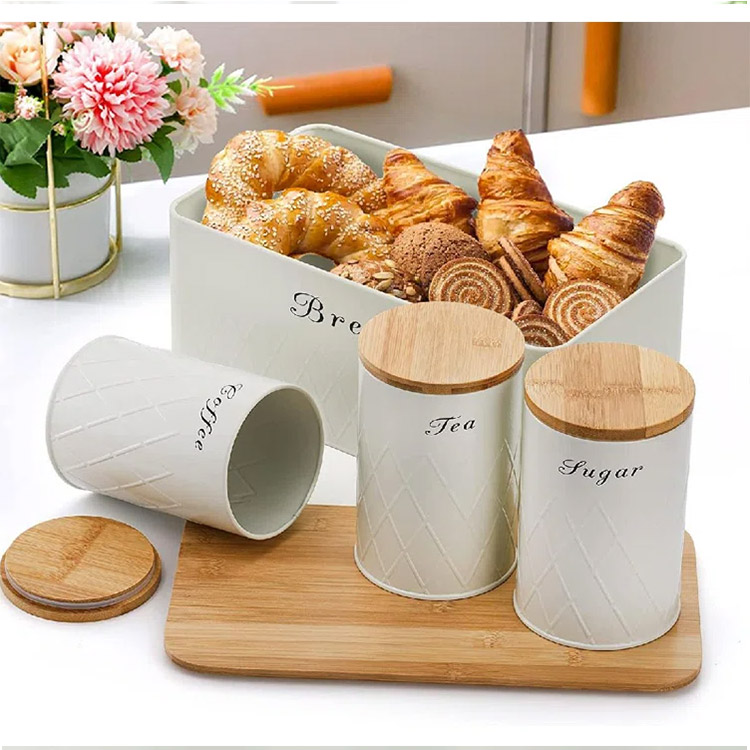
**The Advantages of Metal Bread Boxes and the Strength of Manufacturers** Metal bread boxes have long been a staple in kitchens, offering a sleek, sturdy, and practical solution for storing fresh bread. Here, we delve into the specific advantages of metal bread boxes and highlight the capabilities of the factories that craft them.
**Advantages of Metal Bread Boxes:** 1. **Sturdy and Durable Construction**: Metal bread boxes are renowned for their robustness. Made from high-quality materials like steel or aluminum, they can withstand the rigors of daily use, ensuring a long lifespan. 2. **Excellent Protection**: The airtight seal of metal bread boxes effectively keeps bread fresh for longer periods. Additionally, they provide superior protection from pests, dust, and other contaminants. 3. **Elegant and Versatile Design**: With their sleek and modern designs, metal bread boxes not only store bread but also complement a range of kitchen décors. Their neutral colors and minimalistic styles make them easily integrable into any setting. 4. **Easy Maintenance**: Metal surfaces are easy to clean, resistant to stains, and can be wiped down quickly. This simplicity in maintenance makes metal bread boxes a practical and hassle-free choice. **The Strength of Metal Bread Box Manufacturers:** Factories specializing in metal bread boxes boast impressive capabilities. Here are some key strengths that set them apart: 1. **Advanced Manufacturing Processes**: Utilizing the latest technologies, these factories ensure precision and efficiency in every step of the production process, from material selection to final assembly. 2. **Strict Quality Control**: Manufacturers adhere to rigorous quality standards, ensuring that each metal bread box meets the highest criteria for durability, functionality, and aesthetics. 3. **Customization Capabilities**: Many factories offer customization options, allowing clients to choose from a range of materials, colors, sizes, and designs to suit their specific needs. 4. **Scalable Production**: With flexible production lines, factories can easily scale up or down to meet market demands, ensuring timely delivery and cost-effectiveness. In conclusion, metal bread boxes offer a superior storage solution for fresh bread, combining sturdiness, elegance, and practicality.Backed by the strength and expertise of dedicated manufacturers, they continue to be a reliable and popular choice in modern kitchens.
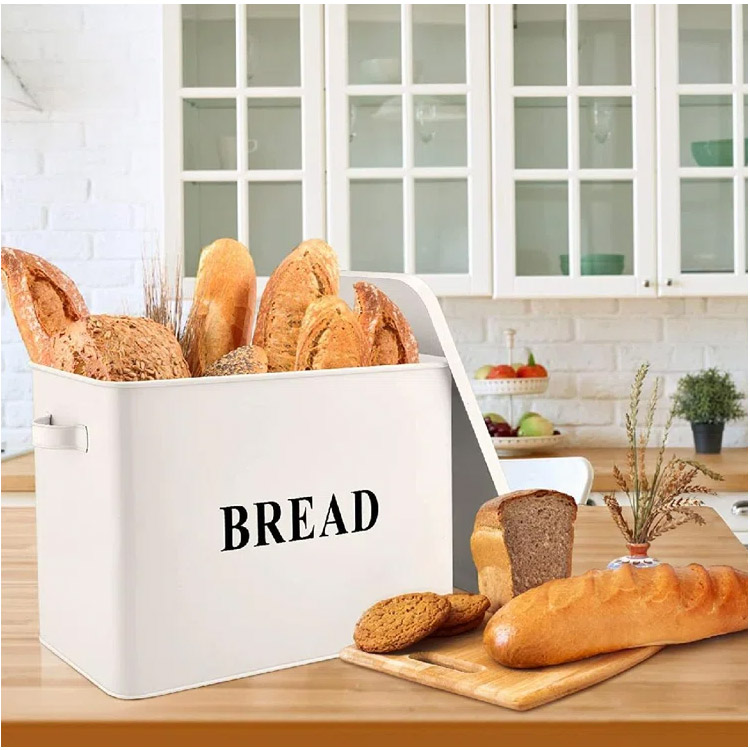
Bread box Bread bins, also known as bread storage containers, are kitchen essentials designed to keep bread fresh and accessible. They come with a range of functional features that make them indispensable in any household. Let's explore these features in detail.
**Airtight Seal for Freshness** One of the most crucial aspects of bread storage is maintaining freshness. Bread Box Bread Storage Containers are equipped with airtight seals that effectively lock out moisture and air, both of which can cause bread to stale quickly. By creating a barrier between the bread and the external environment, airtight seals preserve the bread's texture, flavor, and overall freshness for extended periods. **Importance of Keeping Bread Fresh** Fresh bread is not only more appetizing and enjoyable to eat but also contains essential nutrients that can deteriorate with time.Stale bread loses its flavor and texture, becoming dry and unpalatable. Additionally, stale bread may also lose some of its nutritional value. Therefore, it is essential to store bread in a way that preserves its freshness for as long as possible. **How Airtight Seals Work to Preserve Freshness** Airtight seals work by creating a tight seal around the opening of the Bread Box Bread Storage Containers. This seal prevents air and moisture from entering the bin, thus slowing down the staling process. The lack of oxygen inside the bin also inhibits the growth of mold and other microorganisms that can cause bread to spoil. **Easy Access and Closing Mechanisms**Bread Box Bread Storage Containers are designed for easy access and closing, making it convenient to retrieve bread whenever needed. Most bread bins have lids that lift off easily or slide open, allowing quick access to the contents. Some bins also come with locking mechanisms that keep the lid securely closed, preventing children or pets from accidentally opening them. **Types of Lids and Closures Available** There are various types of lids and closures available for Bread Box Bread Storage Containers. Some common options include hinged lids that lift up, sliding lids that move sideways, and clip-on lids that attach securely to the bin. Each type of lid has its own advantages and can be chosen based on personal preference and the specific needs of the household. **Space-saving Designs** Kitchens often have limited space, making it essential to choose storage solutions that are space-efficient. Bread bins come in a range of sizes and shapes, including compact and vertical designs that are perfect for small kitchens. These designs make it easy to store bread without sacrificing valuable counter or cabinet space. **Versatility and Multipurpose Use**
Bread Box Bread Storage Containers are not just for storing bread; they can also be used for a variety of other purposes. Many people use them to store pastries, cookies, or other baked goods. Some bread bins are even large enough to hold loaves of bread and other larger items like cakes or pies. The versatility of these bins makes them a great addition to any kitchen. In conclusion, Bread Box Bread Storage Containers are an excellent storage solution for keeping bread fresh and accessible. Their airtight seals, easy access and closing mechanisms, space-saving designs, and versatility make them an indispensable part of any kitchen.
**Aesthetic and Decorative Aspects of Bread Bins**
Bread bins, also known as bread boxes, bread storage containers, or even bread holders, serve not only a functional purpose in the kitchen but also contribute significantly to its overall aesthetics. These versatile storage solutions have evolved over time to become statement pieces that not only keep bread fresh but also enhance the kitchen's decor.
As a statement piece in the kitchen, a bread bin can be a focal point, drawing attention to its stylish design and complementing the surrounding decor. Whether it's a sleek and modern metal bin or a rustic wooden one, the right bread bin can tie the kitchen's theme together and make a bold statement about the homeowner's taste.
Bread box come in a wide range of stylish and unique designs, catering to different tastes and kitchen styles. From minimalistic designs to intricate patterns, there is no shortage of options when it comes to choosing a bread bin that speaks to your personal sense of style. Some bins even come with additional features like built-in cutting boards or knife blocks, making them even more versatile and convenient.
Customization options further add to the appeal of bread bins. Many manufacturers offer the option to personalize bread bins with engravings or even paint, allowing homeowners to create a one-of-a-kind piece that perfectly reflects their personality and style. This level of personalization not only makes the bread box more unique but also adds a sentimental value to it.
For those feeling creative, DIY projects involving old bread bins are a great way to repurpose and upcycle these kitchen essentials. With a little imagination and elbow grease, an old bread bin can be transformed into a planter, a storage unit for kitchen utensils, or even a unique piece of furniture.
Bread box also make for thoughtful and practical gifts for home cooks. Whether it's for a housewarming, a birthday, or any other special occasion, a high-quality bread bin is a gift that keeps on giving. With customizable options available, you can even add a personal touch to the gift, making it even more special and meaningful. In conclusion, bread bins are not just functional storage solutions; they are also versatile and stylish pieces that can elevate the aesthetics of any kitchen. From statement pieces to personalized gifts, there is no denying the decorative and aesthetic value that these humble kitchen essentials bring to the table.
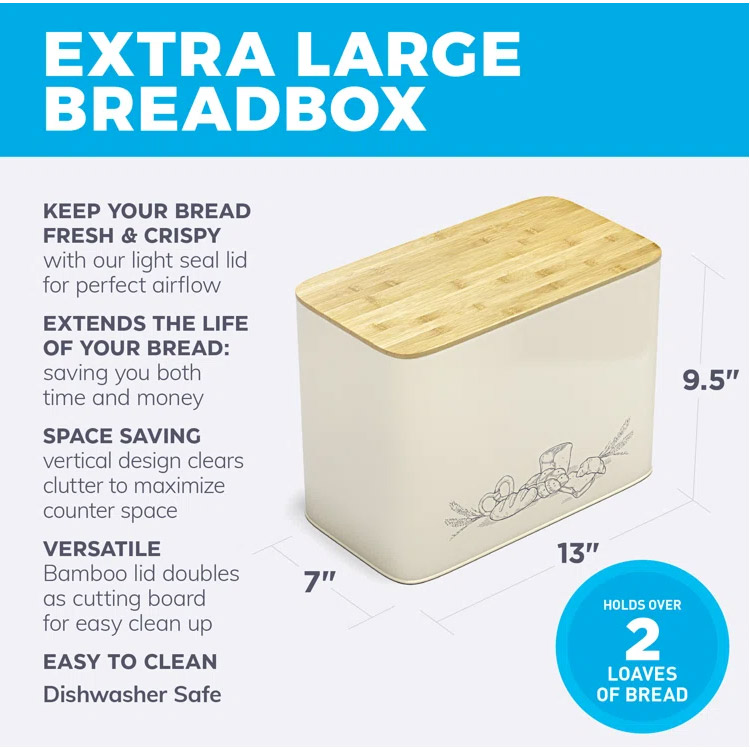
**Buying Guide for Bread Boxes**
When it comes to selecting a bread box, also commonly known as a bread storage container, there are several factors to consider. This buying guide will help you narrow down your choices and find the perfect bread box for your needs.
**Determining the Right Size and Capacity**
One of the first things to consider is the size and capacity of the bread box. Think about how much bread your household consumes in a week and choose a box that can comfortably accommodate those amounts. If you bake your own bread or buy larger loaves, you'll need a box with a generous capacity.
**Factors to Consider When Choosing a Bread Bin Size**
Consider the space available in your kitchen and where you plan to place the bread box. Measure the area to ensure the box won't be too big or too small for the designated spot. Also, think about whether you want a box that can hold multiple loaves or just a single loaf.
**Tips for Measuring and Estimating Capacity Needs**
To get a better idea of the capacity you need, measure the size of the bread loaves you typically buy or bake. This will give you a rough estimate of the interior dimensions you should look for in a bread box. Remember to leave some extra space for airflow and easy access to the bread.
**Selecting the Right Material**
Bread boxes are available in a variety of materials, including wood, metal, plastic, and ceramic. Each material has its own set of pros and cons. Wood, for instance, is natural and eco-friendly but requires more maintenance. Metal is durable and easy to clean but can be noisy when handled. Plastic is lightweight and inexpensive but may not be as durable as other materials. Ceramic is attractive and heat-resistant but can be heavy and fragile.
**Matching Material to Kitchen Style and Decor**
When selecting a material for your bread box, consider the overall style and decor of your kitchen. Choose a material that complements your existing cabinets, countertops, and appliances for a cohesive look.
**Considering Budget and Price Points**
Bread boxes come in a wide range of prices, depending on the material, size, and brand. Set a budget before you start shopping to help narrow down your options. Keep in mind that higher-priced boxes may offer more features and better quality, but there are also affordable options that can meet your needs.
**Finding the Best Value for Your Money**
Look for bread boxes that offer a good balance of price and quality. Read product descriptions carefully and compare features and prices across different brands and models. Consider factors like durability, ease of cleaning, and aesthetics to determine which box offers the best value for your money.
**Reading Customer Reviews and Ratings**
Before making a purchase, it's always a good idea to read customer reviews and ratings. These can provide valuable insights into the quality, performance, and durability of the bread box you're considering. Look for reviews that mention specific features or issues that are important to you.
**Importance of Customer Feedback in Purchase Decisions**
Customer feedback can be a powerful tool in helping you make informed purchase decisions. Positive reviews can confirm that a product meets its claims, while negative reviews can alert you to potential problems or shortcomings. Pay attention to both types of reviews and use them to weigh the pros and cons of each option.
**Where to Find Reliable Reviews and Ratings Online**
You can find reliable reviews and ratings for bread boxes on a variety of online platforms, including e-commerce websites, review sites, and social media. Look for reviews that are detailed, unbiased, and provide specific information about the product's performance and quality.
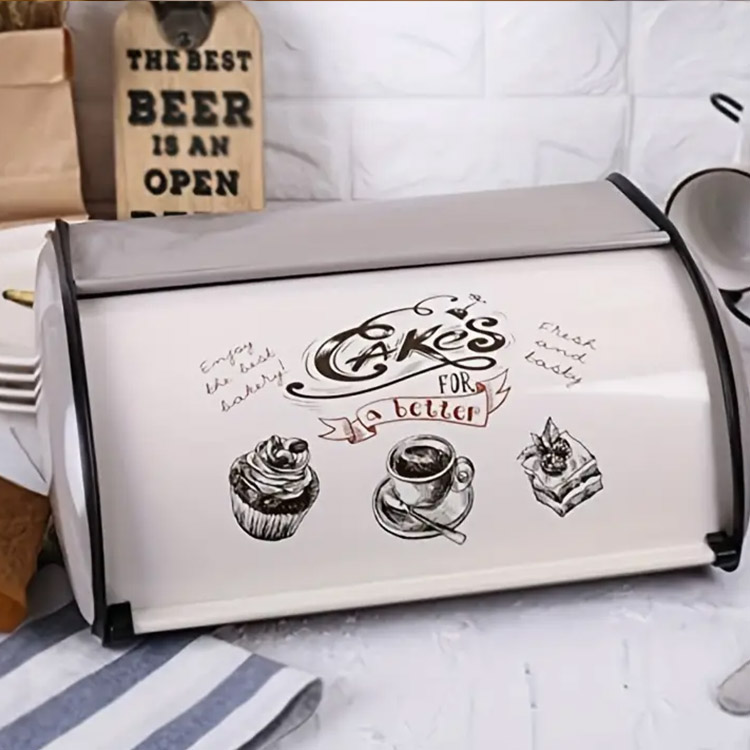
**Care and Maintenance of Metal Bread Storage Containers**
Metal bread storage containers are a staple in many kitchens due to their durability, sleek appearance, and excellent functionality. However, to ensure that these containers serve you well for a long time, it's essential to follow proper care and maintenance practices. Here's a guide on how to clean, sanitize, and maintain your metal bread bin to prevent mold and mildew growth and extend its lifespan.
**Cleaning and Sanitizing Bread Bins**
Metal bread bins should be cleaned regularly to remove any crumbs, dust, or other debris that may accumulate inside. Start by emptying the bin completely and wiping down the interior and exterior surfaces with a damp cloth. For stubborn stains or grease, you can use a mild soap or detergent. Be sure to rinse the bin thoroughly with clean water to remove any soap residue. To sanitize the bin and eliminate any potential mold or mildew spores, you can use a solution of vinegar and water. Mix equal parts vinegar and water in a bowl and apply it to the bin's surfaces using a clean cloth. Let the solution sit for a few minutes before wiping it off with a damp cloth. Vinegar is a natural disinfectant that is safe to use on metal surfaces.
**Regular Cleaning Schedule for Different Materials**
While metal bread bins are relatively easy to clean and maintain, it's important to establish a regular cleaning schedule. Depending on how often you use the bin and the type of bread you store, you may need to clean it weekly or even daily. For light use, a weekly cleaning should suffice. However, if you notice any mold or mildew growth, it's important to clean the bin immediately and increase the frequency of your cleaning schedule.
**Safe Cleaning Products and Methods to Use**
When cleaning metal bread bins, it's important to use safe and non-abrasive cleaning products. Avoid using harsh chemicals or abrasive cleaners that can scratch or damage the metal surface. Stick to mild soaps, detergents, and vinegar solutions for the best results. Additionally, be sure to use soft cloths or sponges to avoid scratching the bin's interior.
**Preventing Mold and Mildew Growth**
Mold and mildew thrive in damp and dark environments, so it's important to keep your metal bread bin dry and well-ventilated. After cleaning the bin, be sure to dry it thoroughly with a clean cloth before using it again. If possible, store the bin in a dry and well-lit area of your kitchen to prevent moisture accumulation.
**Tips for Keeping Bread Bins Dry and Mold-Free**
To further prevent mold and mildew growth, consider lining the bottom of your metal bread bin with a layer of absorbent material like paper towels or a thin cloth. This will help absorb any moisture that may accumulate inside the bin. Additionally, you can place a small container of desiccant (a substance that absorbs moisture) inside the bin to help keep it dry.
**Troubleshooting Mold or Mildew Issues**
If you notice mold or mildew growth in your metal bread bin despite your best efforts to keep it clean and dry, there may be an underlying issue with the bin or your storage practices. First, inspect the bin for any cracks or leaks that could be allowing moisture to enter. If you find any damage, consider repairing or replacing the bin. Additionally, review your storage practices to ensure that you're not introducing moisture into the bin unintentionally. For example, avoid storing damp or wet bread in the bin, and be sure to let any freshly baked bread cool completely before storing it.
**Extending the Lifespan of Bread Bins**
To extend the lifespan of your metal bread bin, it's important to handle it with care and avoid any rough treatment that could damage the metal surface. Additionally, be sure to followlow the manufacturer's instructions for care and maintenance, as different metals may require different cleaning methods and products.
**Caring for and Maintaining Different Materials Over Time**
While metal bread bins are generally durable and easy to maintain, it's important to be aware of any specific care instructions that may apply to your particular bin. Some metals may be prone to rust or corrosion if exposed to moisture or certain cleaning products, so it's important to use the right cleaning methods and products to avoid damaging the bin.
**Repair Options for Damaged or Worn-Out Bread Bins**
If your metal bread bin becomes damaged or worn out over time, you may have options for repair depending on the type and severity of the damage. Minor scratches or dents can often be buffed out with a metal polish or repaired with a touch-up paint kit. For more significant damage, such as cracks or leaks, you may need to seek professional repair services or replace the bin entirely.
**Environmental Impact and Sustainability Considerations of Metal Bread Boxes**
Metal bread boxes, also known as metal bread storage containers, are a popular choice for storing bread due to their durability and longevity. However, as with any product, it's important to consider their environmental impact and sustainability. Here's a closer look at these aspects:
**Environmental Impact of Metal Bread Box Materials**
The environmental impact of metal bread boxes primarily depends on the type of metal used and its production process. Some metals, like stainless steel, are relatively eco-friendly because they are recyclable and have a low carbon footprint compared to other materials. However, extracting and processing metals can be energy-intensive and may involve harmful chemicals, which can negatively impact the environment.
**Comparing the Sustainability of Different Materials**
When comparing the sustainability of different materials for bread boxes, it's important to consider factors such as recyclability, durability, and the environmental impact of production. Metal bread boxes are generally more durable than those made from plastic or wood, which means they have a longer lifespan and reduce the need for frequent replacements. Additionally, metals can often be recycled, making them a more sustainable choice in the long run.
**Eco-Friendly Alternatives to Traditional Materials**
If you're looking for eco-friendly alternatives to traditional metal bread boxes, consider options made from sustainable materials like bamboo or recycled plastic. These materials have a lower environmental impact and are often more biodegradable than metals.
**Recycling and Upcycling Options for Old Bread Bins**
If you have an old metal bread bin that you no longer use, consider recycling or upcycling it. Many recycling centers accept metal items, including bread bins, for processing into new products. Alternatively, you can upcycle your old bread bin by repurposing it into a storage container for other items or even transforming it into a piece of home decor.
**Creative Ways to Repurpose or Recycle Old Bread Bins**
There are countless creative ways to repurpose or recycle old metal bread bins. Some ideas include using them as planters for indoor plants, organizing tools or craft supplies, or even creating a unique piece of furniture like a side table or shelf.
**How to Properly Dispose of Damaged or Unusable Bread Bins**
If your metal bread bin is damaged or no longer usable, it's important to dispose of it properly to avoid harming the environment. Contact your local recycling center or waste management company to inquire about the best way to dispose of metal items in your area. They may provide guidance on whether the bin can be recycled or if it should be discarded as general waste.
**Encouraging Sustainable Practices in Bread Bin Use**
To encourage sustainable practices in bread bin use, consider buying secondhand or refurbished bread bins to reduce the demand for new products. Additionally, opt for bread bins made from recycled or sustainable materials whenever possible. You can also promote eco-friendly kitchen habits by using reusable bags or containers for storing bread instead of single-use plastic bags.
**Tips for Reducing Waste and Conserving Resources When Using Bread Bins**
When using metal bread bins, there are several tips you can followlow to reduce waste and conserve resources:
* Choose the right size bin for your needs to avoid excess material use. *
Keep the bin clean and dry to extend its lifespan and prevent mold growth.
* Repair any damage to the bin instead of replacing it whenever possible. *
Consider using the bin for other storage purposes when you no longer need it for bread.
By following these tips and incorporating sustainable practices into your bread bin use, you can help reduce your environmental impact and promote a more eco-friendly kitchen.
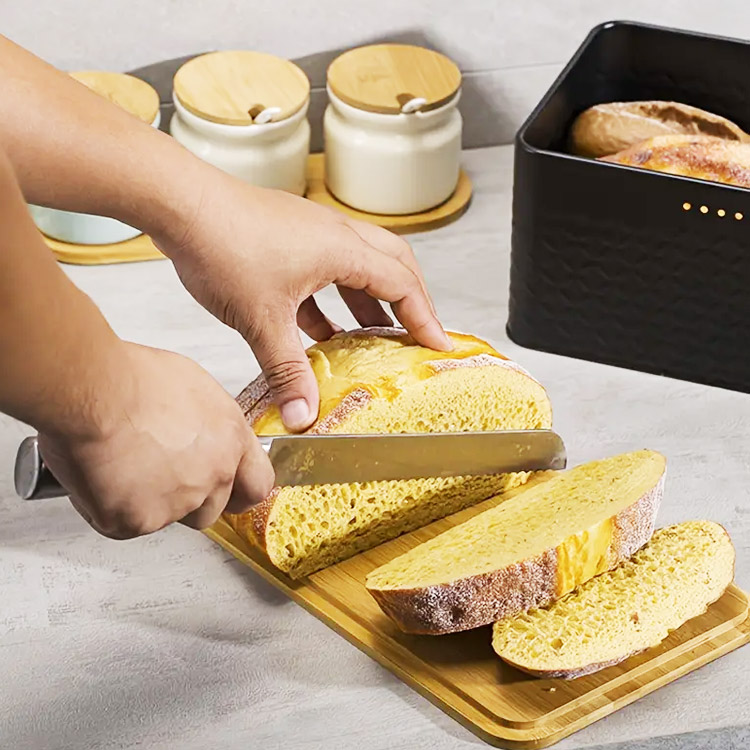
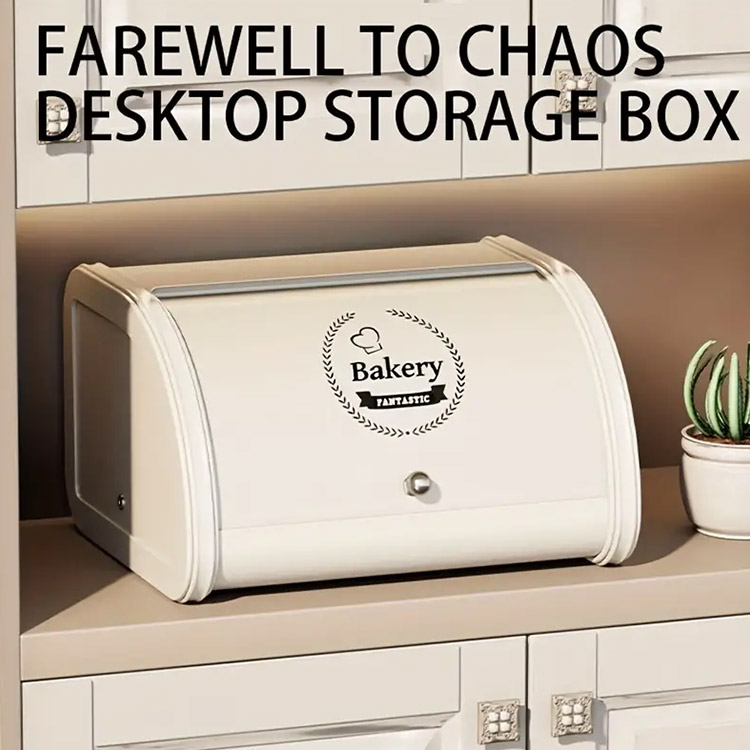
**Conclusion: The Importance of the Right Bread Box**
In essence, a bread box or bread storage container is more than just a simple kitchen utensil; it's a reflection of our lifestyle choices and commitment to environmental responsibility. Whether you opt for a traditional metal design or a more eco-friendly alternative, the key is to find a bread box that suits your needs while also minimizing its environmental footprint.
Durability, recyclability, and repurposing potential are all critical factors to consider when selecting a bread box. And let's not forget the aesthetics—a stylish and functional bread box can be a great addition to any kitchen, complementing its decor while also serving a practical purpose.
In conclusion, choosing the right bread box is about striking a balance between functionality, sustainability, and personal preference. It's a small but significant step in creating a more eco-friendly kitchen and, ultimately, a greener planet.
I invite you to share your thoughts, experiences, and tips on bread boxes in the comments section below. Together, we can learn from each other and make more informed, sustainable choices in our daily lives.
Previous:From Function to Design Exploring the Possibilities of Corrugated Garden Edgin
Next:Garden Watering Can Infusing Vitality and Beauty into Your Garden